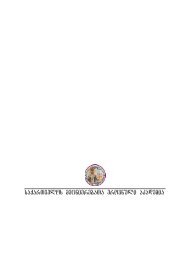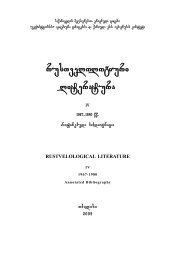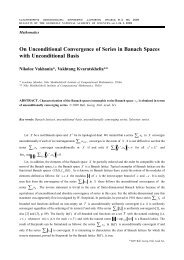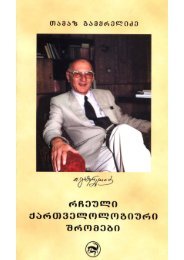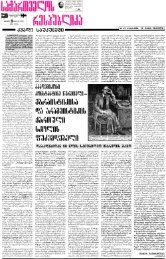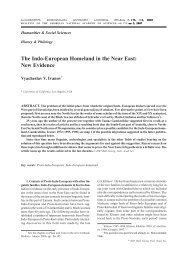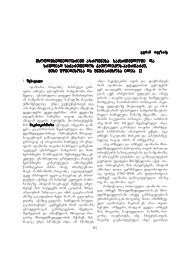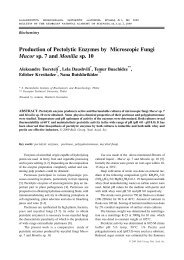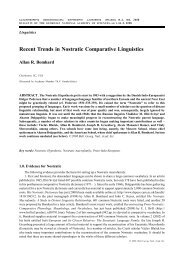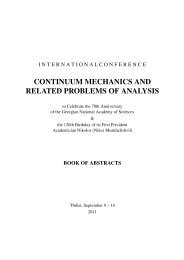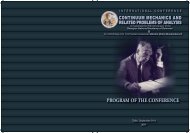The Effects of Diatomaceous Earth on Parasite Infected Goats
The Effects of Diatomaceous Earth on Parasite Infected Goats
The Effects of Diatomaceous Earth on Parasite Infected Goats
Create successful ePaper yourself
Turn your PDF publications into a flip-book with our unique Google optimized e-Paper software.
saqarTvelos mecnierebaTa erovnuli akademiis moambe, t. 3, #1, 2009<br />
BULLETIN OF THE GEORGIAN NATIONAL ACADEMY OF SCIENCES, vol. 3, no. 1, 2009<br />
Biochemistry<br />
<str<strong>on</strong>g>The</str<strong>on</strong>g> <str<strong>on</strong>g>Effects</str<strong>on</strong>g> <str<strong>on</strong>g>of</str<strong>on</strong>g> <str<strong>on</strong>g>Diatomaceous</str<strong>on</strong>g> <str<strong>on</strong>g>Earth</str<strong>on</strong>g> <strong>on</strong> <strong>Parasite</strong> <strong>Infected</strong><br />
<strong>Goats</strong><br />
Gregory Bernard*, Mulumebet Worku**, and Mohamed Ahmedna**<br />
* Fungal Genomics Laboratory, North Carolina State University, 840 Main Campus Drive, Suite 1200 Raleigh, NC 27606, USA<br />
** North Carolina Agricultural and Technical State University, B.C. Webb Hall, 1601 East Market Street, Greensboro, NC<br />
27411, USA<br />
(Presented by Academy Member N. Aleksidze)<br />
ABSTRACT. <str<strong>on</strong>g>Diatomaceous</str<strong>on</strong>g> earth (DE) is the skeletal remains <str<strong>on</strong>g>of</str<strong>on</strong>g> single-celled algae, or diatoms from freshwater<br />
or marine sedimentary deposits. To evaluate the benefits <str<strong>on</strong>g>of</str<strong>on</strong>g> the use <str<strong>on</strong>g>of</str<strong>on</strong>g> DE in goats the effects <str<strong>on</strong>g>of</str<strong>on</strong>g> DE <strong>on</strong><br />
internal parasite c<strong>on</strong>trol was studied. Twenty Spanish and Spanish/Boer crosses were infected with 1.77 g<br />
(Group 1), 3.54 g (Group 2), and 5.31 g (Group 3) <str<strong>on</strong>g>of</str<strong>on</strong>g> DE. Body weights, fecal egg count (FEC), packed cell<br />
volume (PCV), white and red blood cell counts and body weights were recorded over 6 weeks. Highly significant<br />
differences in PCV, FEC, and white blood cell (WBC) and red blood cell (RBC) counts and body weights<br />
were observed between all groups. Over the course <str<strong>on</strong>g>of</str<strong>on</strong>g> the study increases in FEC were observed. <str<strong>on</strong>g>The</str<strong>on</strong>g> PCV<br />
decreased in all groups. Each group exhibited increases in WBC and decreases in RBC counts over the course<br />
<str<strong>on</strong>g>of</str<strong>on</strong>g> the study. An anthelmintic effect <str<strong>on</strong>g>of</str<strong>on</strong>g> DE was not observed. <str<strong>on</strong>g>The</str<strong>on</strong>g> analysis <str<strong>on</strong>g>of</str<strong>on</strong>g> treatment effects <strong>on</strong> weights<br />
showed highly significant differences am<strong>on</strong>g treatments (P < 0.0001). A positive gain occurred in the mean<br />
weights <str<strong>on</strong>g>of</str<strong>on</strong>g> Group 1 and 2, which received the lowest dosage <str<strong>on</strong>g>of</str<strong>on</strong>g> DE. Group 3, which received the highest dose<br />
<str<strong>on</strong>g>of</str<strong>on</strong>g> DE, did not show statistically significant differences after the treatment. Exposure to DE in water may<br />
c<strong>on</strong>tribute to physiological changes in goats that impact performance. Further study is needed to evaluate the<br />
effect <strong>on</strong> performance characteristics in goats such as weight gain, attributable to treatment with DE.<br />
© 2009 Bull. Georg. Natl. Acad. Sci.<br />
Keywords: diatomaceous; goat, nematodes, anthelmintic.<br />
1. Introducti<strong>on</strong><br />
Infecti<strong>on</strong> with gastrointestinal nematodes such as<br />
Haem<strong>on</strong>chus c<strong>on</strong>tortus, and the development <str<strong>on</strong>g>of</str<strong>on</strong>g> anthelmintic<br />
resistance are major c<strong>on</strong>straints to ec<strong>on</strong>omic goat<br />
producti<strong>on</strong> in the southern USA [1]. <str<strong>on</strong>g>The</str<strong>on</strong>g> evaluati<strong>on</strong> <str<strong>on</strong>g>of</str<strong>on</strong>g><br />
alternative anthelmintics will provide scientific validati<strong>on</strong><br />
for comm<strong>on</strong>ly used approaches to address these<br />
c<strong>on</strong>straints.<br />
<str<strong>on</strong>g>Diatomaceous</str<strong>on</strong>g> earth (DE) is the skeletal remains <str<strong>on</strong>g>of</str<strong>on</strong>g><br />
single-celled algae, or diatoms that formed sedimentary<br />
deposits when they died. <str<strong>on</strong>g>Diatomaceous</str<strong>on</strong>g> earth is comprised<br />
predominantly <str<strong>on</strong>g>of</str<strong>on</strong>g> silic<strong>on</strong> dioxide. It is a fine, crumbly<br />
substance used in insulating materials, abrasives,<br />
ceramics, as a food additive, in toothpaste, as an anticaking<br />
agent in artificial sweeteners, as a bio-filter and<br />
in grain storage am<strong>on</strong>g numerous applicati<strong>on</strong>s [2-4].<br />
Korunic [5] observed that <str<strong>on</strong>g>Diatomaceous</str<strong>on</strong>g> earth has low<br />
mammalian toxicity and is registered as a feed additive.<br />
Use <str<strong>on</strong>g>of</str<strong>on</strong>g> DE to c<strong>on</strong>trol internal parasites in organic<br />
livestock producti<strong>on</strong> is widely reported [6]. Studies have<br />
suggested that inclusi<strong>on</strong> <str<strong>on</strong>g>of</str<strong>on</strong>g> a certain grade <str<strong>on</strong>g>of</str<strong>on</strong>g> DE in the<br />
diet <str<strong>on</strong>g>of</str<strong>on</strong>g> grazing ruminants may <str<strong>on</strong>g>of</str<strong>on</strong>g>fer benefits in c<strong>on</strong>trolling<br />
internal parasites [2]. However there is a lack <str<strong>on</strong>g>of</str<strong>on</strong>g><br />
scientific evidence supporting its efficacy [6] especially<br />
© 2009 Bull. Georg. Natl. Acad. Sci.
130 Gregory Bernard, Mulumebet Worku, and Mohamed Ahmedna<br />
in goats. <strong>Goats</strong> present several unique metabolic, physiological<br />
and immunological attributes compared to those<br />
in sheep or cattle [7]. <str<strong>on</strong>g>The</str<strong>on</strong>g>se differences could modulate<br />
the interacti<strong>on</strong>s between DE and nematode parasites. In<br />
light <str<strong>on</strong>g>of</str<strong>on</strong>g> the value placed by organic livestock producers<br />
in feeding DE and in resp<strong>on</strong>se to the need for alternatives<br />
to anthelmintics currently in use, a study was c<strong>on</strong>ducted<br />
to evaluate the utility <str<strong>on</strong>g>of</str<strong>on</strong>g> DE for internal parasite<br />
c<strong>on</strong>trol in goats.<br />
2. Materials and methods<br />
2.1. Animals and sampling<br />
Twenty naturally infected Spanish, and Spanish/Boer<br />
crossed female goats at the North Carolina Agricultural<br />
and Technical State University meat goat herd were used.<br />
<str<strong>on</strong>g>The</str<strong>on</strong>g> animals were reared outdoors in sheltered pens<br />
c<strong>on</strong>taining automatic watering systems, and c<strong>on</strong>crete<br />
flooring. <str<strong>on</strong>g>The</str<strong>on</strong>g> goats were fed a basal diet Southern States<br />
SSC – 31-911800 Goat Feed, 17% crude protein (Southern<br />
States Cooperative Incorporated). Water was administered<br />
<strong>on</strong> an ad libtum basis.<br />
<str<strong>on</strong>g>The</str<strong>on</strong>g> goats were randomly assigned to four groups c<strong>on</strong>taining<br />
five per pen. <str<strong>on</strong>g>The</str<strong>on</strong>g> average body weight per group<br />
was 40 kg. <str<strong>on</strong>g>The</str<strong>on</strong>g> goats had acquired a natural parasite burden<br />
through pasture grazing. Each group received dosages<br />
<str<strong>on</strong>g>of</str<strong>on</strong>g> <str<strong>on</strong>g>Diatomaceous</str<strong>on</strong>g> earth (DE) (Perma-Guard Inc Gilbert,<br />
AZ) at different c<strong>on</strong>centrati<strong>on</strong>s for a period <str<strong>on</strong>g>of</str<strong>on</strong>g> eight days.<br />
Group 1 received a drench <str<strong>on</strong>g>of</str<strong>on</strong>g> 1.77 g DE in 150 ml sterile<br />
distilled water (50 µg/kg body weight). Group 2 was<br />
drenched with 3.54 g DE in 150 ml sterile distilled water<br />
(100 µg/kg body weight). Group 3 received a treatment <str<strong>on</strong>g>of</str<strong>on</strong>g><br />
5.31 g DE in 150 ml sterile distilled water (150 µg/kg body<br />
weight). Group 4 was administered with 150 ml sterile<br />
distilled water and served as untreated c<strong>on</strong>trols.<br />
<str<strong>on</strong>g>The</str<strong>on</strong>g> initial weights <str<strong>on</strong>g>of</str<strong>on</strong>g> all goats were recorded prior<br />
to the start <str<strong>on</strong>g>of</str<strong>on</strong>g> this study. Subsequent weekly measurements<br />
were recorded. Animals were weighed and fecal<br />
and blood samples were taken weekly for six weeks.<br />
2.2. Fecal egg counts<br />
Fecal samples were collected from the rectum weekly<br />
to measure nematode egg excreti<strong>on</strong>. Eggs per gram <str<strong>on</strong>g>of</str<strong>on</strong>g><br />
feces were evaluated using a modified versi<strong>on</strong> <str<strong>on</strong>g>of</str<strong>on</strong>g> the<br />
McMaster’s method. <str<strong>on</strong>g>The</str<strong>on</strong>g> egg counts were c<strong>on</strong>ducted in<br />
duplicate using McMaster slides (Paracount kit, Chalex<br />
Corporati<strong>on</strong>, Issaquah, WA) as recommended by the<br />
manufacturer. Approximately 2 grams <str<strong>on</strong>g>of</str<strong>on</strong>g> fecal samples<br />
were collected and mixed with a supersaturated sodium<br />
chloride floatati<strong>on</strong> soluti<strong>on</strong>. <str<strong>on</strong>g>The</str<strong>on</strong>g> combinati<strong>on</strong> was then<br />
loaded <strong>on</strong>to a McMaster slide and eggs counted using a<br />
microscope using a magnificati<strong>on</strong> <str<strong>on</strong>g>of</str<strong>on</strong>g> 100x. Total eggs<br />
per gram were determined for each treatment.<br />
2.3. White and red blood cell counts<br />
Peripheral blood samples were collected weekly from<br />
the jugular vein in Vacutainer tubes (Bect<strong>on</strong> Dickins<strong>on</strong>)<br />
c<strong>on</strong>taining 0.7 ml acid citrate dextrose anti-coagulant<br />
for hematological analyses. Blood samples with anticoagulant<br />
were prepared for automated electr<strong>on</strong>ic counting<br />
<str<strong>on</strong>g>of</str<strong>on</strong>g> total red cells (RBC) and total white blood cells<br />
(WBC) by using the Coulter Diluter Dispenser 10 and<br />
counter (Coulter Z Series Particle Counter and Size<br />
Analyzer, Beckman Coulter, Inc. Fullert<strong>on</strong>, CA).<br />
<str<strong>on</strong>g>The</str<strong>on</strong>g> relative proporti<strong>on</strong>s <str<strong>on</strong>g>of</str<strong>on</strong>g> white blood cell types were<br />
calculated from blood smears stained with SureStain Wright<br />
Methanol Soluti<strong>on</strong>. A total <str<strong>on</strong>g>of</str<strong>on</strong>g> 100 white blood cells were<br />
counted. Basophils, lymphocytes, eosinophils, m<strong>on</strong>ocytes,<br />
and neutrophils were identified and counted in duplicate<br />
and averaged <strong>on</strong>ce per week throughout the experiment.<br />
2.4. Detecti<strong>on</strong> <str<strong>on</strong>g>of</str<strong>on</strong>g> packed cell volume<br />
An aliquot <str<strong>on</strong>g>of</str<strong>on</strong>g> blood with anticoagulant from each<br />
goat was collected in micro-capillary tubes and then<br />
centrifuged for 10 minutes at 14 000 rpm in an IEC MB<br />
Micro Hematocrit centrifuge (Dam<strong>on</strong>/IEC Divisi<strong>on</strong>).<br />
After centrifugati<strong>on</strong>, samples were analyzed for PCV in<br />
a micro-capillary reader (Dam<strong>on</strong>/IEC Divisi<strong>on</strong>).<br />
2.5. Statistical analysis<br />
Statistical analyses were performed using the SAS<br />
statistical analysis s<str<strong>on</strong>g>of</str<strong>on</strong>g>tware (SAS Institute Incorporated,<br />
Cary, NC). Analysis <str<strong>on</strong>g>of</str<strong>on</strong>g> Variance (ANOVA) was performed<br />
to determine significant differences am<strong>on</strong>g treatments.<br />
A Dunnett’s T test was c<strong>on</strong>ducted for treatment<br />
comparis<strong>on</strong>s, in which group 4 and week 0 were used as<br />
c<strong>on</strong>trols. Before analysis, outliers were removed from<br />
the original data using a special SAS macro program.<br />
3. Results and discussi<strong>on</strong><br />
3.1. Fecal egg count in goats following treatment<br />
Figure 1 shows the effect <str<strong>on</strong>g>of</str<strong>on</strong>g> DE <strong>on</strong> the number <str<strong>on</strong>g>of</str<strong>on</strong>g><br />
eggs per gram (EPG) <str<strong>on</strong>g>of</str<strong>on</strong>g> feces in goats. Haem<strong>on</strong>chus<br />
c<strong>on</strong>tortus, Eimeria, and Trichostr<strong>on</strong>gylus spp. were the<br />
predominant species <str<strong>on</strong>g>of</str<strong>on</strong>g> nematodes present throughout<br />
the trial. <str<strong>on</strong>g>The</str<strong>on</strong>g>re were highly significant differences am<strong>on</strong>g<br />
treatment groups (P < 0.0001). Variati<strong>on</strong>s in fecal egg<br />
counts for weekly measurements also proved to be highly<br />
significant (P < 0.0001). Group 2 showed the lowest<br />
mean fecal egg count increase while Group 3 showed<br />
the highest after the administrati<strong>on</strong> <str<strong>on</strong>g>of</str<strong>on</strong>g> DE. <str<strong>on</strong>g>The</str<strong>on</strong>g> results<br />
<str<strong>on</strong>g>of</str<strong>on</strong>g> this study coincide with previous experiments involving<br />
DE which c<strong>on</strong>firmed no significant reducti<strong>on</strong>s <str<strong>on</strong>g>of</str<strong>on</strong>g><br />
fecal egg counts in sheep [8]. Despite the promoted use<br />
<str<strong>on</strong>g>of</str<strong>on</strong>g> DE as an effective anthelmintic [6,8], the evidence<br />
presented in this study does not support DE as an effective<br />
alternative de-worming drench for goats.<br />
Bull. Georg. Natl. Acad. Sci., vol. 3, no. 1, 2009
<str<strong>on</strong>g>The</str<strong>on</strong>g> <str<strong>on</strong>g>Effects</str<strong>on</strong>g> <str<strong>on</strong>g>of</str<strong>on</strong>g> <str<strong>on</strong>g>Diatomaceous</str<strong>on</strong>g> <str<strong>on</strong>g>Earth</str<strong>on</strong>g> <strong>on</strong> <strong>Parasite</strong> <strong>Infected</strong> <strong>Goats</strong> 131<br />
EPG<br />
10000<br />
9000<br />
8000<br />
7000<br />
6000<br />
5000<br />
4000<br />
3000<br />
2000<br />
1000<br />
0<br />
0 1 2 3 4 5 6<br />
Weeks<br />
Fig. 1. Fecal egg count (EPG) <str<strong>on</strong>g>of</str<strong>on</strong>g> feces from goats treated with different doses <str<strong>on</strong>g>of</str<strong>on</strong>g> <str<strong>on</strong>g>Diatomaceous</str<strong>on</strong>g> earth. Group 1, treated animals with 1.77 g DE (•);<br />
Group 2, treated animals with 3.54 g DE (•); Group 3, treated animals with 5.31 g DE (); Group 4, untreated animals (). Error bars<br />
represent the mean±standard deviati<strong>on</strong> (n=6). Weekly measurements P < 0.0001; treatment by Group P < 0.0001.<br />
3.2. Packed cell volume levels in goat blood following<br />
treatment<br />
<str<strong>on</strong>g>The</str<strong>on</strong>g> PCV values observed ranged within the normal<br />
range for <str<strong>on</strong>g>of</str<strong>on</strong>g> goats (22% to 38%) [9]. <str<strong>on</strong>g>The</str<strong>on</strong>g> effect <str<strong>on</strong>g>of</str<strong>on</strong>g> treatments<br />
<strong>on</strong> PCV was found to be significant (P < 0. 02;<br />
Figure 2). All groups showed decreases in PCV: -4.6413<br />
(Group 1), -1.1560 (group 2), -3.1345 (group 3) when<br />
compared to the c<strong>on</strong>trol (Group 4). <str<strong>on</strong>g>The</str<strong>on</strong>g>re were no significant<br />
differences in the treatments by week and the week by<br />
group interacti<strong>on</strong>s (P < 0.1; P > 0.1, respectively). Treatment<br />
with DE did not improve the mean PCV. <str<strong>on</strong>g>The</str<strong>on</strong>g>se results<br />
agree with previous studies in lambs [8].<br />
35<br />
30<br />
Packed cell volume (%)<br />
25<br />
20<br />
15<br />
10<br />
5<br />
0<br />
0 1 2 3 4 5 6<br />
Weeks<br />
Fig. 2. Packed cell volume (%) <str<strong>on</strong>g>of</str<strong>on</strong>g> goats treated with different doses <str<strong>on</strong>g>of</str<strong>on</strong>g> <str<strong>on</strong>g>Diatomaceous</str<strong>on</strong>g> earth. Group 1, treated animals with 1.77 g DE (•); Group 2,<br />
treated animals with 3.54 g DE (•); Group 3, treated animals with 5.31 g DE (); Group 4, untreated animals (). Error bars represent the<br />
mean±standard deviati<strong>on</strong> (n=6). Weekly measurements P < 0.1; treatment by Group P > 0.1.<br />
Bull. Georg. Natl. Acad. Sci., vol. 3, no. 1, 2009
132 Gregory Bernard, Mulumebet Worku, and Mohamed Ahmedna<br />
3.3. Changes in white and red blood cell counts in goats<br />
following treatment<br />
<str<strong>on</strong>g>The</str<strong>on</strong>g> treatments had a significant overall effect <strong>on</strong><br />
the total white blood cell counts (P < 0.0001; Figure 3).<br />
<str<strong>on</strong>g>The</str<strong>on</strong>g> effect is due to the ’number <str<strong>on</strong>g>of</str<strong>on</strong>g> weeks’ <str<strong>on</strong>g>of</str<strong>on</strong>g> infecti<strong>on</strong><br />
following treatment (weekly measurements, P < 0.001).<br />
No statistically different effects were observed for the<br />
“group” by treatment interacti<strong>on</strong> (P > 0.1). Each group<br />
showed an increase in the mean WBC count with the<br />
increase in the number <str<strong>on</strong>g>of</str<strong>on</strong>g> weeks from the first week<br />
(week 1) and up to the last week (week 6). <str<strong>on</strong>g>The</str<strong>on</strong>g> increased<br />
mean WBC may be a reflecti<strong>on</strong> <str<strong>on</strong>g>of</str<strong>on</strong>g> the increased<br />
parasite burdens indicated by the observed increased fecal<br />
egg counts [10].<br />
<str<strong>on</strong>g>The</str<strong>on</strong>g> total RBC count was significantly different<br />
am<strong>on</strong>g treatment groups (P < 0.01; Figure 4); weekly<br />
measurements <str<strong>on</strong>g>of</str<strong>on</strong>g> mean RBC were significantly different<br />
over time (P 0.1).<br />
Figure 5 shows the relative changes in white blood<br />
cell differential counts in goats treated with DE when<br />
compared to those from untreated c<strong>on</strong>trols. <str<strong>on</strong>g>The</str<strong>on</strong>g>re was a<br />
dose- dependent difference in the neutrophil to lymphocyte<br />
ratio following DE treatment. Similar directi<strong>on</strong>al<br />
changes were observed in neutophils and m<strong>on</strong>ocytes as<br />
compared to lymphocytes.<br />
All groups dem<strong>on</strong>strated a mild decrease in eosinophil<br />
counts from preliminary recordings after the administrati<strong>on</strong><br />
<str<strong>on</strong>g>of</str<strong>on</strong>g> DE treatment. Eosinophilia is a feature<br />
<str<strong>on</strong>g>of</str<strong>on</strong>g> helminth infecti<strong>on</strong>s [11]. Breed differences in the levels<br />
<str<strong>on</strong>g>of</str<strong>on</strong>g> eosinophils have been observed between Spanish<br />
and Spanish boer crosses [12]. Exposure to DE has an<br />
impact <strong>on</strong> the leukogram similar to those associated with<br />
genetic differences and envir<strong>on</strong>emtnal exposure in goats<br />
[12].<br />
Reports <strong>on</strong> the systemic resp<strong>on</strong>ses to Haem<strong>on</strong>chus<br />
c<strong>on</strong>tortus in sheep indicate a neutrophil leukocytosis no<br />
definitive eosinophilia and an antibody resp<strong>on</strong>se [10].<br />
4500<br />
4000<br />
3500<br />
WBC counts (Milli<strong>on</strong>/L)<br />
3000<br />
2500<br />
2000<br />
1500<br />
1000<br />
500<br />
0<br />
Bull. Georg. Natl. Acad. Sci., vol. 3, no. 1, 2009<br />
0 1 2 3 4 5 6<br />
Weeks<br />
Fig. 3. Total white blood cell counts <str<strong>on</strong>g>of</str<strong>on</strong>g> goats treated with different doses <str<strong>on</strong>g>of</str<strong>on</strong>g> <str<strong>on</strong>g>Diatomaceous</str<strong>on</strong>g> earth. Group 1, treated animals with 1.77 g DE (•);<br />
Group 2, treated animals with 3.54 g DE (•); Group 3, treated animals with 5.31 g DE (); Group 4, untreated animals (). Error bars<br />
represent the mean±standard deviati<strong>on</strong> (n=6). Weekly measurements P < 0.001; treatment by Group P > 0.1.
<str<strong>on</strong>g>The</str<strong>on</strong>g> <str<strong>on</strong>g>Effects</str<strong>on</strong>g> <str<strong>on</strong>g>of</str<strong>on</strong>g> <str<strong>on</strong>g>Diatomaceous</str<strong>on</strong>g> <str<strong>on</strong>g>Earth</str<strong>on</strong>g> <strong>on</strong> <strong>Parasite</strong> <strong>Infected</strong> <strong>Goats</strong> 133<br />
3500000<br />
3000000<br />
RBC count (milli<strong>on</strong>/L)<br />
2500000<br />
2000000<br />
1500000<br />
1000000<br />
500000<br />
0<br />
0 1 2 3 4 5 6<br />
Weeks<br />
Fig. 4. Red blood cell counts <str<strong>on</strong>g>of</str<strong>on</strong>g> goats treated with different doses <str<strong>on</strong>g>of</str<strong>on</strong>g> <str<strong>on</strong>g>Diatomaceous</str<strong>on</strong>g> earth. Group 1, treated animals with 1.77 g DE (•); Group 2,<br />
treated animals with 3.54 g DE (•); Group 3, treated animals with 5.31 g DE (); Group 4, untreated animals (). Error bars represent the<br />
mean±standard deviati<strong>on</strong> (n=6). Weekly measurements P < 0.0001; treatment by Group P < 0.01.<br />
12<br />
Lymphocytes Basophils Eosinophils Neutrophils M<strong>on</strong>ocytes<br />
9<br />
Relative change (%)<br />
6<br />
3<br />
0<br />
-3<br />
-6<br />
-9<br />
-12<br />
Group 1 Group 2 Group3<br />
Fig. 5. Relative changes in goats’ white blood cell differential count compared to counts from untreated animals. Dose <str<strong>on</strong>g>of</str<strong>on</strong>g> <str<strong>on</strong>g>Diatomaceous</str<strong>on</strong>g> earth used:<br />
Group 1, treated animals with 1.77 g DE; Group 2, treated animals with 3.54 g DE; Group 3, treated animals with 5.31 g DE. Positive value<br />
indicates a relative increase and negative values a relative decrease.<br />
<str<strong>on</strong>g>The</str<strong>on</strong>g> systemic pattern observed in Figure 5 may reflect an<br />
inflammatory and immune resp<strong>on</strong>se associated with DE<br />
administrati<strong>on</strong>, the levels <str<strong>on</strong>g>of</str<strong>on</strong>g> parasites and genetic variati<strong>on</strong>s<br />
between goats. This needs further investigati<strong>on</strong>.<br />
3.5. Goat body weight changes following treatment<br />
Highly significant differences were observed in body<br />
weight am<strong>on</strong>g treatments (P < 0.0001; Figure 6). A<br />
positive gain occurred in the mean weights <str<strong>on</strong>g>of</str<strong>on</strong>g> Group 1<br />
and 2, which received the lowest dosage <str<strong>on</strong>g>of</str<strong>on</strong>g> DE. Group<br />
3, which received the highest DE, did not show any<br />
statistically significant difference after the treatment.<br />
<str<strong>on</strong>g>The</str<strong>on</strong>g> results are similar to those <str<strong>on</strong>g>of</str<strong>on</strong>g> treatments <str<strong>on</strong>g>of</str<strong>on</strong>g> DE in<br />
sheep, where increases in weights were reported [8].<br />
Further study is needed to evaluate the effect <strong>on</strong> performance<br />
characteristics such as weight gain attributable<br />
to treatment with DE in goats.<br />
Bull. Georg. Natl. Acad. Sci., vol. 3, no. 1, 2009
134 Gregory Bernard, Mulumebet Worku, and Mohamed Ahmedna<br />
Weight (Kg)<br />
50<br />
45<br />
40<br />
35<br />
30<br />
25<br />
20<br />
15<br />
10<br />
0 1 2 3 4 5 6<br />
Weeks<br />
Fig. 6. Weight changes in goats treated with different doses <str<strong>on</strong>g>of</str<strong>on</strong>g> <str<strong>on</strong>g>Diatomaceous</str<strong>on</strong>g> earth. Group 1, treated animals with 1.77 g DE (•); Group 2, treated<br />
animals with 3.54 g DE (•); Group 3, treated animals with 5.31 g DE (); Group 4, untreated animals (). Error bars represent the<br />
mean±standard deviati<strong>on</strong> (n=6). Weekly measurements and treatment by Group P < 0.0001.<br />
4. C<strong>on</strong>clusi<strong>on</strong>s<br />
<str<strong>on</strong>g>The</str<strong>on</strong>g> results <str<strong>on</strong>g>of</str<strong>on</strong>g> this study did not indicate significant<br />
effects <str<strong>on</strong>g>of</str<strong>on</strong>g> DE <strong>on</strong> the parasite load as measured by eggs<br />
per gram <str<strong>on</strong>g>of</str<strong>on</strong>g> feces. <str<strong>on</strong>g>The</str<strong>on</strong>g> progressi<strong>on</strong> <str<strong>on</strong>g>of</str<strong>on</strong>g> parasitemia was<br />
not affected. Variability was observed in the leukogram<br />
and may be associated with immune resp<strong>on</strong>se, genetic<br />
variati<strong>on</strong> or result from exposure to trace elements in DE.<br />
Further study is needed to evaluate the effect <str<strong>on</strong>g>of</str<strong>on</strong>g> DE in<br />
different breeds <str<strong>on</strong>g>of</str<strong>on</strong>g> goats, and its effect <strong>on</strong> performance<br />
characteristics such as weight gain and the immune resp<strong>on</strong>se<br />
to support the use <str<strong>on</strong>g>of</str<strong>on</strong>g> DE in goat producti<strong>on</strong>.<br />
bioqimia<br />
diatomitebis gavlena parazitebiT inficirebul<br />
Txebze<br />
g. bernardi, m. vorku, m. ahmedna<br />
* Crd. karolinas universiteti, relei, aSS<br />
** Crd. karolinas agraruli da teqnikuri universiteti, grinsboro, aSS<br />
(warmodgenilia akademiis wevris n. aleqsiZis mier)<br />
Seswavlilia diatomitebis, rogorc antihelminturi preparatis gamoyenebis perspeqtiva kuWnawlavis<br />
nematodebis Haem<strong>on</strong>chus c<strong>on</strong>tortus-is sawinaaRmdegod. diatomitebis gavlena sxvadasxva<br />
Bull. Georg. Natl. Acad. Sci., vol. 3, no. 1, 2009
<str<strong>on</strong>g>The</str<strong>on</strong>g> <str<strong>on</strong>g>Effects</str<strong>on</strong>g> <str<strong>on</strong>g>of</str<strong>on</strong>g> <str<strong>on</strong>g>Diatomaceous</str<strong>on</strong>g> <str<strong>on</strong>g>Earth</str<strong>on</strong>g> <strong>on</strong> <strong>Parasite</strong> <strong>Infected</strong> <strong>Goats</strong> 135<br />
parametrebze Seiswavleboda sakvebis danamatis saxiT dinamikaSi. Txebis sxeulis w<strong>on</strong>a, parazitis<br />
kvercxebis raodenoba, leikocitebisa da eriTrocitebis raodenoba mniSvnelovnad icvleboda<br />
mxolod eqsperimentis sawyis etapze. preparatma gavlena iq<strong>on</strong>ia Txebis eriTrocitebisa da<br />
leikocitebis raodenobaze, magram kvlevis am pirobebSi ar gamovlinda misi antihelminturi<br />
efeqti.<br />
REFERENCES<br />
1. L.L. Mortensen, L.H. Williams<strong>on</strong>, T.H. Terrill (2003), Evaluati<strong>on</strong> <str<strong>on</strong>g>of</str<strong>on</strong>g> prevalence and clinical implicati<strong>on</strong>s <str<strong>on</strong>g>of</str<strong>on</strong>g> anthelmintic<br />
resistance in gastrointestinal nematodes <str<strong>on</strong>g>of</str<strong>on</strong>g> goats. J. American Veter. Med. Assoc. 223(4), 495-500.<br />
2. B.M. L. McLean, D. Frost, D.E. Evans, A. Clarke, B. Griffiths (2005), <str<strong>on</strong>g>The</str<strong>on</strong>g> inclusi<strong>on</strong> <str<strong>on</strong>g>of</str<strong>on</strong>g> <str<strong>on</strong>g>Diatomaceous</str<strong>on</strong>g> earth in the diet <str<strong>on</strong>g>of</str<strong>on</strong>g><br />
grazing ruminants and its effects <strong>on</strong> gastrointestinal parasite burdens. Researching sustainable systems. Proceedings <str<strong>on</strong>g>of</str<strong>on</strong>g> the<br />
First Scientific C<strong>on</strong>ference <str<strong>on</strong>g>of</str<strong>on</strong>g> the Internati<strong>on</strong>al Society <str<strong>on</strong>g>of</str<strong>on</strong>g> Organic Agriculture Research. Eds – U. Kopke, U. Niggli, D.<br />
Neuh<str<strong>on</strong>g>of</str<strong>on</strong>g>f, P. Cornish, W. Lockeretz, H. Willer, Adelaide, South Australia.<br />
3. A. Nikpay (2006), <str<strong>on</strong>g>Diatomaceous</str<strong>on</strong>g> earths as alternatives to chemical insecticides in stored grain. Insect Sci. 13, 421-429.<br />
4. V.S. Mohan, R.M. Krishna, P. Muralikrishna, S. Shailaja, P.N. Sarma (2007), Solid phase bioremediati<strong>on</strong> <str<strong>on</strong>g>of</str<strong>on</strong>g> pendimethalin<br />
in c<strong>on</strong>taminated soil and evaluati<strong>on</strong> <str<strong>on</strong>g>of</str<strong>on</strong>g> leaching potential. Biores. Technol. 98(15), 2905-2910.<br />
5. Z. Korunic (1998), <str<strong>on</strong>g>Diatomaceous</str<strong>on</strong>g> earths, a group <str<strong>on</strong>g>of</str<strong>on</strong>g> natural insecticides. J. Stored Prod. Res. 34 (2/3), 87-97.<br />
6. J. Sooby, J. Landeck, M. Lips<strong>on</strong> (2007), Nati<strong>on</strong>al organic research agenda, soils, and pests. Livestock, genetics. Outcomes<br />
from the Scientific C<strong>on</strong>gress <strong>on</strong> Organic Agricultural Research (SCOAR). Organic Farming Research Foundati<strong>on</strong>. Santa<br />
Cruz, CA. http://<str<strong>on</strong>g>of</str<strong>on</strong>g>rf.org/publicati<strong>on</strong>s/pubs/nora.pdf.<br />
7. N. Silanikove (2000), <str<strong>on</strong>g>The</str<strong>on</strong>g> physiological basis <str<strong>on</strong>g>of</str<strong>on</strong>g> adaptati<strong>on</strong> in goats to harsh envir<strong>on</strong>ments. Small Rumin. Res. 35, 181–<br />
193.<br />
8. G.D. Osweiler, T.L. Cars<strong>on</strong> (Eds) (1997), Evaluati<strong>on</strong> <str<strong>on</strong>g>of</str<strong>on</strong>g> <str<strong>on</strong>g>Diatomaceous</str<strong>on</strong>g> earth as an adjunct to sheep parasite c<strong>on</strong>trol in<br />
organic farming. In: Leopold Center for Sustainable Agriculture Progress Reports. Vol. 6. Iowa State University, Ames,<br />
Iowa, USA.<br />
9. O.M. Radostits, C.C. Gay, D.C. Blood, K.W. Hinchcliff (2000), Veterinary Medicine, 9th Ed., ELBS Bailliere Tindall,<br />
Philadelphia, USA, pp. 870-871.<br />
10. D.B. Adams (1993), Systemic resp<strong>on</strong>ses to challenge infecti<strong>on</strong> with Haem<strong>on</strong>chus c<strong>on</strong>tortus in immune merino sheep.<br />
Veterin. Res. Commun. 17, 25-35.<br />
11. K. Leder, P.F. Weller (2000), Eosinophilia and helminthic infecti<strong>on</strong>s. Best Practice Res. Clin. Haemat. 13(2), 301-317.<br />
12. G. Kannan, K.E. Saker, T.H. Terrila, B. Kouakoua, S. Galipallia, S. Gelayea (2007), Effect <str<strong>on</strong>g>of</str<strong>on</strong>g> seaweed extract supplementati<strong>on</strong><br />
in goats exposed to simulated preslaughter stress. Small Rum. Res. 73, 221-226.<br />
Received October, 2008<br />
Bull. Georg. Natl. Acad. Sci., vol. 3, no. 1, 2009



